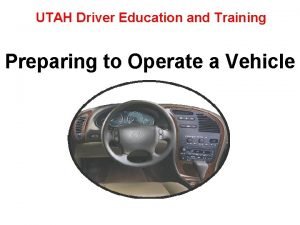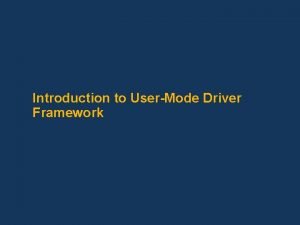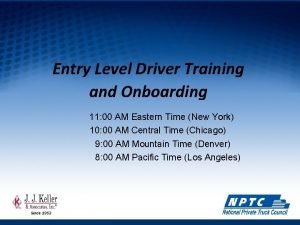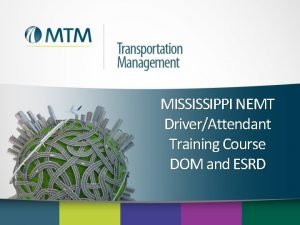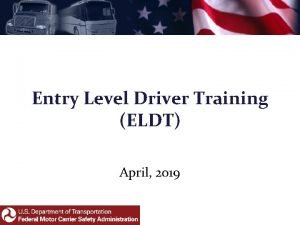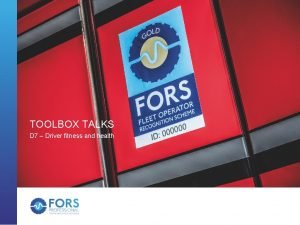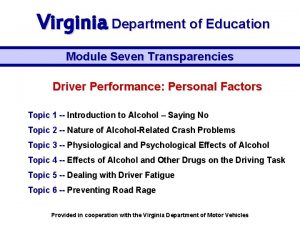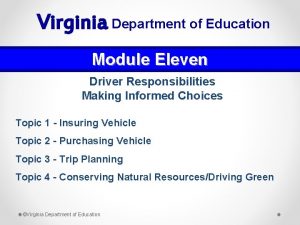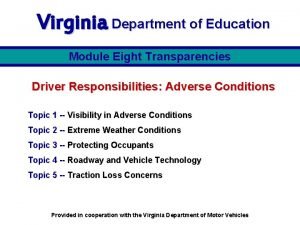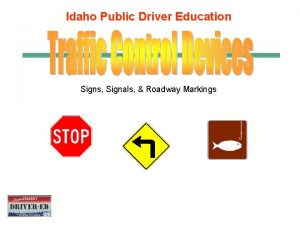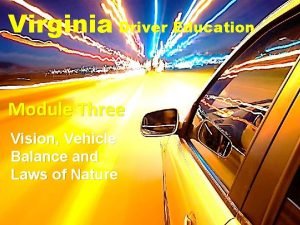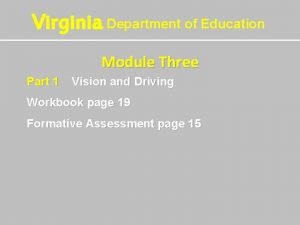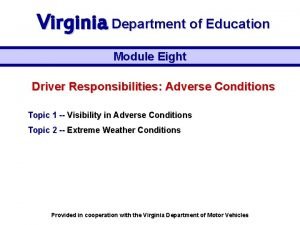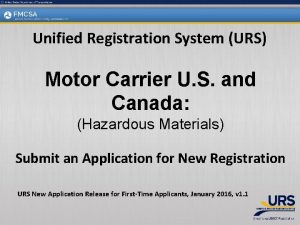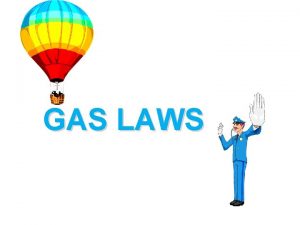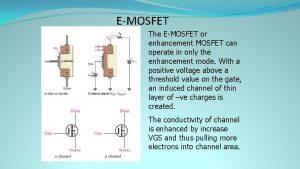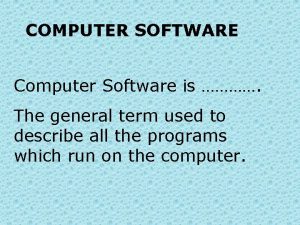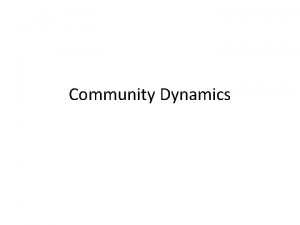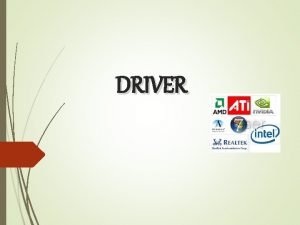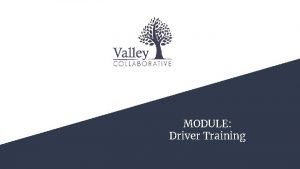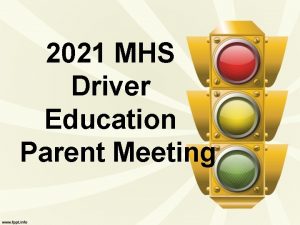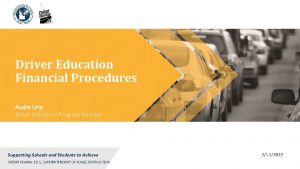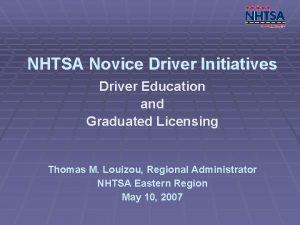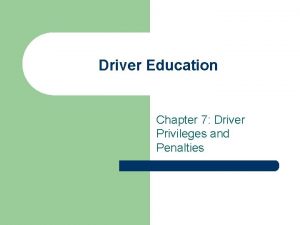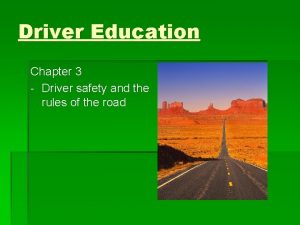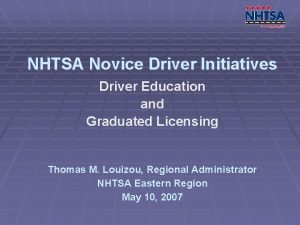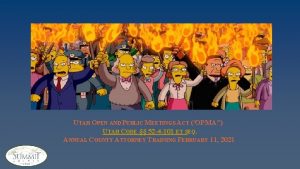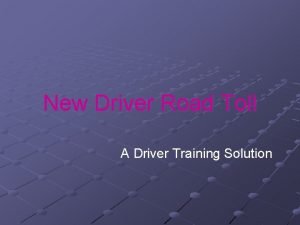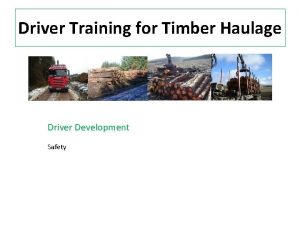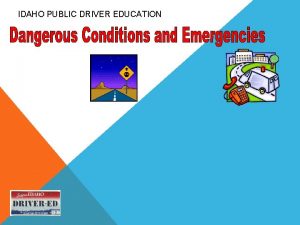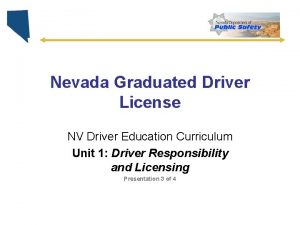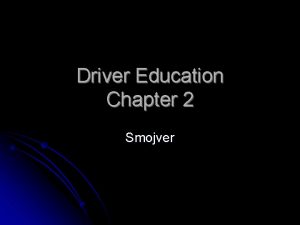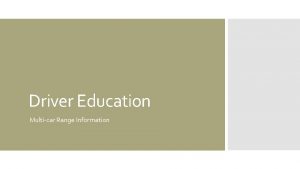UTAH Driver Education and Training Preparing to Operate


























- Slides: 26

UTAH Driver Education and Training Preparing to Operate a Vehicle

Approaching ü When parked at the curb q Approach from the front of the car q Increase awareness of oncoming traffic q Approach the driver’s door with key in hand ü When parked in a parking lot q Approach from rear of car q Increase awareness of people and objects nearby q Approach the driver’s door with key in hand

Approaching ü Check around the outside of the vehicle q Objects in path of vehicle q Unwanted passengers q Children, pets q Fluid leaks q Tire condition q Direction front tires are turned (which way will the vehicle move when placed in gear? ) q Body damage q Clean lights

Approaching ü Store valuables in trunk of vehicle q Books and book bags have less chance of slipping off seats q The driver education vehicle is a classroom with no room for § food, candy and soda

Entering • Check traffic flow of approaching vehicles • Unlock doors using electronic device or key • Enter the vehicle quickly as possible to avoid conflicts with other traffic flow • Check door swing • Check passengers for safe entry • Lock doors • Place key in the ignition § Keys may be different for trunk, door, ignition

Adjusting the Vehicle ü Seating Adjustments q Manual or electronic adjustments § Adjust for driver’s foot pedal and dead pedal position § Adjust for best visual needs ü Head Restraint Adjustment q Protect head and neck injuries q Head restraint position § Above ears reduces head whiplash § Below ears increases head whiplash

Steering Wheel üSteering Wheel Adjustments q Angle adjustment lever, steering column and height lever q Be able to place hands on the top of the steering wheel for safe distance from the airbag q Positions for airbag safety § Seating position is minimum of 10 inches from wheel § Hand positions on steering wheel § Beware of airbag deployment venting at 10, 2, and 6 o’clock positions

Mirrors üTraditional Settings q Able to see the complete rear view window within 200’ to the rear of the vehicle q Able to make head checks without moving the head─move only the eyes

Mirrors • Mirrors – Power/Manual Adjustments – Rearview mirror settings (see 200 feet to the rear) – Sideview mirror settings (15 degrees out will enhance side views) Power Adjustment – May be adjusted to view sides rather then rear view – Traditional setting needed when inside mirror view is blocked to rear • Traditional View • BGE Enhanced View

Cones outline the blind areas caused by traditional mirror settings Traditional side view mirror settings shows same view as rear view mirror TRADITIONAL SETTING RIGHT BLIND SPOT RIGHT SIDE VIEW REAR MIRROR LEFT SIDE VIEW TRADITIONAL SETTING LEFT BLIND SPOT VIEW

The BGE enhanced side mirror settings (15 degrees to outside) eliminates right and left side mirror blind areas ENHANCED RIGHT SIDE MIRROR VIEW REAR MIRROR VIEW ENHANCED LEFT SIDE MIRROR VIEW Reference: Blindzone & Glare Elimination (BGE) Mirror Settings (G. Platzer, 1996)

Seatbelts • Seatbelt Adjustments – Use lap and shoulder belts properly for best protection • Lap belt across boney pelvic area • Shoulder belt over collarbone and rib cage – Adjustable shoulder belt anchors on pillars – Tension relieving device adjustments – Check passengers for proper fit and location • Passengers under age 12 sit in the rear seat • Bolsters and special seats may be required

Stop or slow down • • A lawyer runs a stop sign and gets pulled over by a sheriff's deputy. He thinks that he is smarter than the deputy because he is a lawyer from New York and is certain that he has a better education than any cop from Houston, Texas. He decides to prove this to himself and have some fun at the Texas deputy's expense. The deputy says, " License and registration, please. " "What for? " says the lawyer. The deputy says, "You didn't come to a complete stop at the stop sign. " Then the lawyer says, "I slowed down, and no one was coming. " "You still didn't come to a complete stop, says the deputy. License and registration, please. " The lawyer says, "What's the difference? " "The difference is you have to complete stop, that's the law. License and registration, please!" the Deputy says. Lawyer says, "If you can show me the legal difference between slow down and stop, I'll give you my license and registration; and you give me the ticket. If not, you let me go and don't give me the ticket. " "That sounds fair. Please exit your vehicle, Sir, " the deputy says. At this point, the deputy takes out his nightstick and starts beating the lawyer and says, "Do you want me to stop, or just slow down?

Foot Pedals • Accelerator pedal – Right heel of foot on floor for smooth operation – Foot may pivot to and from brake, if pedal position allows – Used to maintain, increase, and decrease speed • Brake pedal – Heel on floor for smooth operation – Foot may pivot to and from accelerator, if pedal position allows – Used to maintain or decrease speed

Foot Pedals • Clutch pedal (if equipped) – Used in manual shift vehicles – Use ankle force with heel on floor, locate friction point for smooth operation • Parking brake pedal (or lever if equipped) – Used with foot on floor board – Some are hand operated near dash or center console – Emphasis on “parking” brake, rather than “emergency” brake – Owner’s manual may indicate use before placing into (P)ark • Dead pedal – Located to the left of the floorboard, may be just a flat spot – Used to maintain driver balance and stability for left foot and leg – Allows right leg and foot to use pedals effectively

Steering Wheel Control üSteering movements q Amount of steering for changing path of travel varies among vehicles q Slow speeds require faster steering movement q Faster speeds require slower steering movement q Turn right – go right, turn left – go left

Locating and Operating Controls ü Cruise/Speed Control (if equipped) q Allows vehicle to maintain constant speed ü Gear Selector Lever q On steering column or center console q Press button lever q (O)verdrive and (D)rive gear ü Ignition Switch q On steering column or dashboard q On/accessories/start/off/

Control, Information, Comfort, and Safety Devices • Turn Signal Lever – Location and use – Lane change signal use • Hazard Flashers – Location and use • Windshield Wipers and Washers – Part of turn signal lever in some vehicles – Opposing lever on some vehicles • Headlights / Running Lights – Where located and use • Horn – Warning device only • Hood Release – Sometimes confused with brake release

Control, Information, Comfort, and Safety Devices • Trunk Release (if equipped) – Inside trunk - safety release device – Location and use • Fuel Door Release (if equipped) – Location and use • Sun Visor – Driver uses left hand – Push away from face for glare protection (crash danger) • Heater/Ventilation/Air Conditioner (HVAC) – Three basic controls and their use • Optional Controls

Control, Information, Comfort, and Safety Devices Instrument Panel q Speedometer q Tachometer (if equipped) q Odometer q Fuel Gauge q Temperature q Oil Pressure q Alternator Charging System q Airbag Alert/Warning Light q Brake System Warning Light q ABS Alert/Warning Light Note: Location and description for all instruments and features are located in the Vehicle Owner’s Manual

Control, Information, Comfort, and Safety Devices Instrument Panel q Turn Signal Indicator Light q High Beam Indicator Light q Others § Theft/Security Light § Speed Control Light § O/D Off § Driver Air Bag (SRS) § Side Impact § Airbag/Curtains § Air Bag Off switch (trucks) § Lighter Note: Location and description for all instruments and features are located in the Vehicle Owner’s Manual

Control, Information, Comfort, and Safety Devices q Other Devices § Auxiliary Power Point § Traction Control Systems § Active Handling Systems § GPS/Mapping Tools § Satellite Communication § Digital Readouts § Electronic Sound System § Center Air Vents § Dual Climate Control Systems Note: Location and description for all instruments and features are located in the Vehicle Owner’s Manual

Securing the Vehicle ü ü ü Locate a legal, safe parking place Stop and set parking brake Shift gear selector to (P)ark (Reverse in Manual Transmission) Close windows Turn off accessories Turn ignition switch to “off” q the engine should shut off at this time ü Lock ignition switch and remove key q required to remove the key in most vehicles ü Unfasten occupant restraints q some shoulder restraints operate when the door is opened

Warning Systems and Controls Air Bag On/Off Switch Battery/Alternator Warning Light Low Oil Pressure Warning Light Air Bag Functioning Brake Warning Light Temperature Indicator Antilock Brake System Functioning Safety Alert Symbol Seat Belt Reminder Fuel Indicator Fuse / Fuse Box Emergency Flashers THEFT Theft-Deterrent System Activation Vent and Air Flow Control 12 Volt Extension Outlet Door Locks Fog Lamps Turn Signal Wipers Stalk Drive Wheel Selector TPMS/Tire Pressure Monitoring System

Warning Systems and Controls Headlights/High Beam Indicator Lighter Indicator Hood Release Exterior Lights Horn Fan Speed Indicator O/D OFF Power Window Controls Rear Defroster Indicator Overdrive On/Off Indicator Cruise Control Device Parking Lamp Indicator Steering Wheel Height Adjustment Left/Right Signal Indicator Front Windshield Defroster Windshield Washer Windshield Wipers ETS OFF Interior Light Adjustment Adjust Left/Right Side Mirror Trunk Release Electronic Traction Control System

Exiting the Vehicle • Check traffic flow and exit the vehicle – Check traffic flow to rear prior to opening the door – Be sure key is in hand – Check door swing into lane of travel – Rear child safety door locks may need to be opened from the driver’s door – Exit quickly to avoid conflicts with traffic – Lock doors – In traffic, walk toward rear of the vehicle
 Utah driver's manual
Utah driver's manual Windows driver foundation - user-mode driver framework
Windows driver foundation - user-mode driver framework Generates fresh produce and other farm products
Generates fresh produce and other farm products Jj keller entry level driver training answer key
Jj keller entry level driver training answer key Pcm imaginer
Pcm imaginer Nemt driver training
Nemt driver training Eclipse driver training
Eclipse driver training Toolbox talks for drivers
Toolbox talks for drivers Drivers ed module 10 topic 1
Drivers ed module 10 topic 1 Module 7 topic 4 drivers ed
Module 7 topic 4 drivers ed Module 11 topic 1 insuring a vehicle
Module 11 topic 1 insuring a vehicle Curriculum guide for driver education in virginia module 8
Curriculum guide for driver education in virginia module 8 Driver education montana
Driver education montana Signs drivers ed
Signs drivers ed What is vehicle balance
What is vehicle balance Standard 4 part 1 a: vehicle balance & control
Standard 4 part 1 a: vehicle balance & control Module 5 topic 3 hills and mountains
Module 5 topic 3 hills and mountains Module 7 topic 1 distracted driving
Module 7 topic 1 distracted driving Ed ch
Ed ch Unified registration system
Unified registration system Urs motor
Urs motor Combined gas law
Combined gas law E mosfet can operate in
E mosfet can operate in General term for programs used to operate a computer
General term for programs used to operate a computer Business entities that operate in a duel market structure
Business entities that operate in a duel market structure Community processes dynamics and empowerment
Community processes dynamics and empowerment Unit 5 international business m2
Unit 5 international business m2
